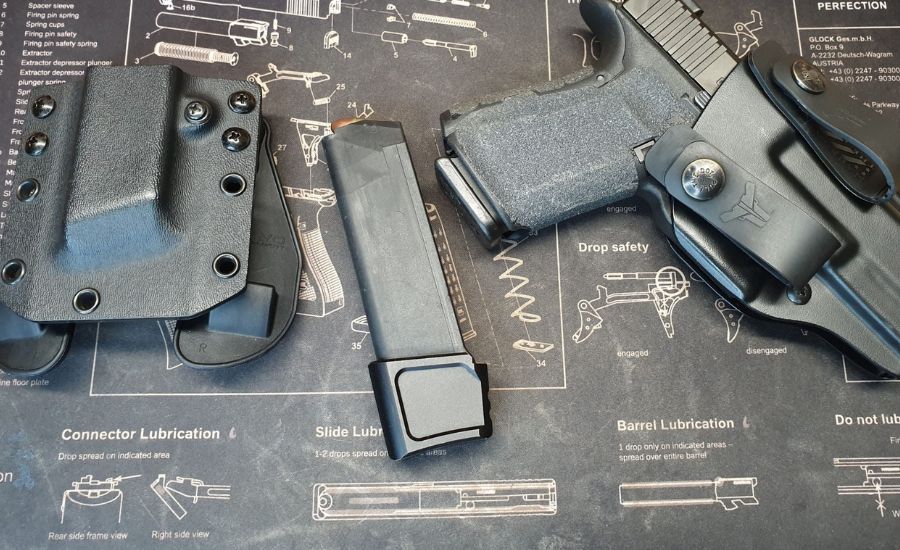Choosing between a Glock 23 mag extension and a standard magazine can be a pivotal decision for gun owners, especially those focused on self-defense and tactical scenarios. Standard magazines offer reliability and adherence to traditional specifications but may lack the necessary capacity in critical situations. On the other hand, mag extensions provide additional rounds, which could be crucial in a self-defense encounter where more shots might mean the difference between safety and peril.
However, the added weight and bulk of extended magazines can affect handling and concealability. This comparison aims to explore the benefits and drawbacks of each option to help you determine which is better suited to your specific needs and legal constraints.
Standard Magazine or Glock 23 Mag Extension – Which is Better
Deciding whether a standard magazine or a Glock 23 mag extension is better depends largely on individual needs and preferences, as each option comes with its own set of advantages and drawbacks. While standard magazines maintain the firearm’s original handling and concealability, they offer limited capacity, which can be a constraint in high-threat environments.
Conversely, mag extensions increase ammunition capacity, potentially giving a tactical advantage, but can alter the weapon’s balance and increase its visibility when concealed. In the sections below, we will discuss the specific benefits and limitations of each type to provide a detailed understanding, helping you make a well-informed decision based on your particular requirements and scenarios.
Glock 23 Mag Extension
Advantages of Glock 23 Mag Extensions
Increased Ammunition Capacity
The increased ammunition capacity provided by a Glock 23 magazine extension is a significant benefit, particularly in self-defense or tactical scenarios. More rounds readily available in the magazine allow for a sustained defensive posture, which can be critical when facing multiple threats or when additional shots are required to neutralize a situation. This extended capacity reduces the frequency of reloads during an encounter, keeping the shooter ready and responsive.
As a result, the shooter can exert greater control over the situation, potentially preventing it from escalating into a more dangerous conflict. Overall, this enhancement provides a tactical edge by ensuring that you are less likely to run out of ammunition at a critical moment.
Enhanced Grip
Magazine extensions can significantly improve the handling and control of a firearm by adding extra surface area to the grip. This additional grip space is particularly beneficial for shooters with larger hands, as it allows for a more secure and comfortable hold. A better grip enhances stability and control over the firearm, which is crucial during rapid firing situations where recoil management is key to maintaining accuracy.
By facilitating a firmer and more ergonomic hold, magazine extensions can lead to more controlled and precise shooting, thereby enhancing overall performance in both tactical and recreational shooting scenarios. This improvement in handling can contribute to a shooter’s confidence and effectiveness, especially under stress.
Drawbacks of Glock 23 Mag Extensions
Altered Weapon Balance
Adding a magazine extension to a firearm alters its weight distribution and balance, which can impact its ergonomic feel. This change may disrupt a shooter’s familiar handling of the weapon, potentially complicating the process of quickly and accurately acquiring targets. For individuals trained extensively with the standard configuration of the firearm, this alteration could lead to decreased precision and effectiveness in shooting. The shift in balance might require additional training and adjustment periods for the user to regain proficiency and comfort, especially in high-pressure situations where rapid response is critical.
Concealability Issues
For concealed carry practitioners, using a magazine extension can complicate the ability to keep a firearm discreetly hidden. The added length and bulk of the extension increase the profile of the gun, making it more difficult to conceal under clothing. This can result in “printing,” where the outline of the firearm becomes visible through the fabric, inadvertently revealing the presence of the gun.
Such visibility can attract unwanted attention and potentially undermine the strategic advantage of carrying concealed. Therefore, those who prefer concealment must carefully consider the trade-offs between increased ammunition capacity and the increased challenge of concealing their weapon effectively.
Potential Reliability Concerns
Introducing aftermarket parts like magazine extensions to a firearm can sometimes affect its reliability, despite advancements in design. These extensions can alter the standard mechanics of the weapon, leading to potential feeding issues or other malfunctions if they are not compatible, properly installed, or maintained.
Firearm owners must ensure that any modifications made are done with precision and that the parts used are of high quality and specifically designed for their model. Regular maintenance and testing after installation are also essential to ensure that the firearm continues to operate as expected, preserving both safety and functionality.
Standard Magazine
Advantages of Standard Magazines
Reliability
Standard magazines, being original equipment manufactured (OEM) parts, are engineered and rigorously tested by the firearm manufacturer to match specific models for optimal performance. These magazines are tailored to fit seamlessly, minimizing the risk of mechanical failures such as feeding issues or jams. Their compatibility is key in ensuring that the firearm operates reliably, especially under critical conditions where functional assurance is crucial.
The precise integration of standard magazines with their respective firearms ensures consistent performance, enhancing the shooter’s confidence in the weapon’s dependability during high-pressure scenarios. This reliability is essential not only for effective operation but also for safety, making standard magazines a preferred choice for many firearm users.
Maintaining Original Weapon Handling
Using a standard magazine on a Glock 23 maintains the firearm in the configuration for which it was originally designed, ensuring that the balance and ergonomics remain as the manufacturer intended. This preservation of the firearm’s original specifications is crucial for shooters who have trained extensively with the Glock 23, as it allows them to capitalize on their familiarity with its handling and response.
Such consistency is vital for achieving high levels of accuracy and optimal performance during use, whether in training, competitive shooting, or defensive scenarios. Keeping the firearm in its standard form avoids the potential learning curve and adjustment period associated with modifications, which can be particularly important in situations where split-second precision is required.
Drawbacks of Standard Magazines
Limited Capacity
The main limitation of standard magazines is their restricted ammunition capacity, which necessitates more frequent reloading. This limitation can be particularly disadvantageous in high-stress scenarios, such as self-defense situations or competitive shooting events, where the ability to fire multiple rounds without interruption can be critical. Having to reload under pressure can leave a shooter vulnerable and may negatively impact the effectiveness of their response.
In intense confrontations where every second matters, the need for additional rounds can be the difference between controlling the situation or being overwhelmed. Thus, for those likely to encounter such scenarios, the limited capacity of standard magazines could be a significant tactical drawback.
Less Flexibility in Tactical Situations
Standard magazines, with their limited capacity, can reduce tactical flexibility, particularly in situations requiring sustained fire or facing multiple threats. In such environments, the need to reload frequently can disrupt momentum and expose the shooter to greater risks. This is especially pertinent in competitive shooting sports, where time spent reloading can affect scores and outcomes significantly.
The reduced number of rounds available also limits the ability to provide suppressive fire or engage multiple targets effectively, potentially compromising both safety and competitive advantage. Thus, the capacity of standard magazines might not suffice in more demanding tactical or competitive situations.
Conclusion
In deciding between a Glock 23 magazine extension and a standard magazine, the best choice largely depends on your specific needs and circumstances. Magazine extensions offer the advantage of increased ammunition capacity, which can be a critical factor in self-defense or competitive situations where reloading time is crucial.
However, this benefit comes with potential downsides, such as altered weapon balance and increased visibility during concealed carry. On the other hand, standard magazines ensure optimal reliability and maintain the firearm’s intended ergonomics and handling characteristics, which might be preferable for those trained extensively with the original setup.
Ultimately, whether the added capacity of an extension outweighs the reliability and familiarity of a standard magazine will depend on your personal preference, intended use, and the scenarios in which you expect to use your firearm. Each option offers distinct advantages and drawbacks, making it important to consider both carefully before making a decision.
Read next: celebriches

Jennifer David is the creative force behind CelebRiches, your go-to source for celebrity financial exploits. With an unwavering passion for the entertainment industry, she delivers in-depth insights into celebrities’ net worth, combining thorough research with a captivating narrative. Explore the stars’ fiscal journeys through Jennifer’s expert lens, where finance meets fame most engagingly.
